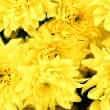Background
- Chrysanthemum is a popular plant for its ornamental, food, and insecticidal uses. Pyrethrins (natural organic compounds) extracted from the seed casings of chrysanthemum, such as Chrysanthemum cinerariifolium and Chrysanthemum coccineum, are used as insecticides and insect repellents. Pyrethrins are known to have a relatively low risk of chronic accumulation, but poisoning may occur from accidental or intentional ingestion or chronic exposure.
- Preliminary laboratory studies suggest that chrysanthemum may be beneficial for the treatment of gout (food inflammation) and may alter immune function. In clinical trials, chrysanthemum has decreased diabetes symptoms and a combination including chrysanthemum reduced pre-cancerous lesions. Although the studies in these areas seem promising, more research is needed.
- The U.S. Food and Drug Administration (FDA) does not list chrysanthemum on its Generally Recognized as Safe (GRAS) list.
References
- Chen K, Plumb GW, Bennett RN, et al. Antioxidant activities of extracts from five anti-viral medicinal plants. J Ethnopharmacol 1-4-2005;96(1-2):201-205.
View Abstract - Groenewoud GC, de Groot H, van Wijk RG. Impact of occupational and inhalant allergy on rhinitis-specific quality of life in employees of bell pepper greenhouses in the Netherlands. Ann Allergy Asthma Immunol 2006;96(1):92-97.
View Abstract - Hadis M, Lulu M, Mekonnen Y, et al. Field trials on the repellent activity of four plant products against mainly Mansonia population in western Ethiopia. Phytother Res 2003;17(3):202-205.
View Abstract - Hussain Z, Waheed A, Qureshi RA, et al. The effect of medicinal plants of Islamabad and Murree region of Pakistan on insulin secretion from INS-1 cells. Phytother Res 2004;18(1):73-77.
View Abstract - Jovanovic M, Poljacki M. [Compositae dermatitis]. Med Pregl. 2003;56(1-2):43-49.
View Abstract - Kim HJ, Lee YS. Identification of new dicaffeoylquinic acids from Chrysanthemum morifolium and their antioxidant activities. Planta Med 2005;71(9):871-876.
View Abstract - Kim KJ, Kim YH, Yu HH, et al. Antibacterial activity and chemical composition of essential oil of Chrysanthemum boreale. Planta Med. 2003;69(3):274-277.
View Abstract - Lee JR, Yang MS, Lee J, et al. New guaianolides from leaves and stems of Chrysanthemum boreale. Planta Med. 2003;69(9):880-882.
View Abstract - Lee JS, Kim HJ, Lee YS. A new anti-HIV flavonoid glucuronide from Chrysanthemum morifolium. Planta Med. 2003;69(9):859-861.
View Abstract - Li LP, Jiang HD. Determination and assay validation of luteolin and apigenin in human urine after oral administration of tablet of Chrysanthemum morifolium extract by HPLC. J Pharm Biomed Anal. 4-11-2006;41(1):261-265.
View Abstract - Macan J, Varnai VM, Turk R. [Health effects of pyrethrins and pyrethroids]. Arh.Hig.Rada Toksikol. 2006;57(2):237-243.
View Abstract - Proudfoot AT. Poisoning due to pyrethrins. Toxicol Rev 2005;24(2):107-113.
View Abstract - Rayman RB. Aircraft disinsection. Aviat.Space Environ.Med 2006;77(7):733-736.
View Abstract - Singh RP, Agrawal P, Yim D, et al. Acacetin inhibits cell growth and cell cycle progression, and induces apoptosis in human prostate cancer cells: structure-activity relationship with linarin and linarin acetate. Carcinogenesis 2005;26(4):845-854.
View Abstract - Swierczyniska-Machura D, Krakowiak A, Palczynski C. [Occupational allergy caused by ornamental plants]. Med Pr 2006;57(4):359-364.
View Abstract







